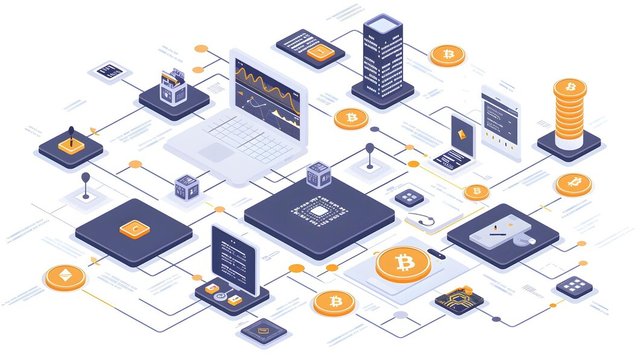The Evolution of Cross-chain Asset Swap
Introduction:
Cross-blockchain asset swaps are now a core feature of the decentralized finance (DeFi) world. The users, therefore, can trade their money in different blockchain networks where there is no need for middlemen, hence there is an improvement in the level of liquidity and market efficiency. Asset transfers initially were only possible within the same blockchain till the proliferation of several blockchain platforms whereby the desire to transfer assets across chains necessitated the creation of new ways of swapping assets.
In the past, the transfer of assets between chains was a big challenge since it required the utilization of intermediaries such as centralized exchanges where people used to trade chains of assets e.g from Bitcoin to Ethereum. Nonetheless, these exchanges stood some problems such as expensive costs, risks, and loss of control of the assets placed during exchange. Since then, DEXs have evolved, allowing users greater control and security for their assets, offering direct, opportunistic swaps without intermediaries.
Centralized exchanges have long posed major consumer problems because they are at risk of asset centralization. Now, users are empower scant attention has evolved technological development incorporating bridges technology systems providing several chain DEX systems. The availability of chains and chain networks has solved these issues, in every case changing the way liquidity is managed in DeFi and fulfilling the wider needs of blockchain integration.
1.) Atomic Swaps:
Atomic swaps can be considered one of the first and also the most reliable methods of exchanging assets between two blockchains. They make it feasible for both participants to directly transfer their coins on different networks without the need for a third party to facilitate the exchange, as a smart contract is used to ensure that funds at both ends are locked and released at the same time. In this case, for example, if one party does not fulfill his obligation, there is no risk of money being lost – the terms of the trade are cancelled out automatically.
The key benefit of atomic swaps is total independence or decentralization. Since they do not require centralized exchanges, users maintain control over their assets throughout the process. However, atomic swaps have limitations, such as there being issues with cross-chain compatibility. Not all blockchains support atomic swaps, which in effect restricts the potential for greater acceptance of the technology, especially for new or more unconventional blockchain platforms.
Nonetheless, these disadvantages do not prevent the usage of atomic swaps and this procedure is still actively voracious today along with newer protocols such as Lightning Network of Bitcoin, as well as Layer 2 Ethereum solutions that tries to increase the speed and scalability of swaps. These improvements contribute to increasing the efficiency of cross-chain trading without compromising security or decentralization.
2.) Cross-chain Bridges:
The advent of cross-chain bridges cut down the barriers of transferring assets from one blockchain to another in an effective manner. These bridges are a means that links together two or more platforms of a particular blockchain or between multiple blockchains allowing transfers of assets like tokens NFTs without exposing them to trauma by way of hacking attacks. For instance, an individual may lock up his or her tokens on chain A and move to chain B where one can mint equivalent tokens against the assets locked on chain A and thereby gain the liquidity for the assets without losing the asset itself.
What’s more important, cross-chain bridges are a tool for balancing liquidity between cohesive ecosystems. A number of existing cross-chain bridges are designed for DeFi in a way that the users cannot be restricted to a single platform even when they are using DeFi protocols. As a disadvantage, these bridges bring the connectedness which can lead to the networks being vulnerable with the common ones being the extinction of the bridging currencies and exposure to smart contract defects.
At the same time, techniques involving cross-chain bridges include a potent way of protecting risks for users in DeFi and bringing in stablecoins or tokens into the applications. It is observed that various projects; Polkadot, Cosmos and Thorchain aim to create networks and enable technologies which focus on ease of asset flow and effective outcomes between various blockchains. These protocols will probably keep on developing providing better and advanced smart contracts that will support cross-chain swaps in the future.
3.) Decentralized Exchanges (DEXs):
Decentralized exchanges (DEXs) have contributed to the advancement of cross-chain asset exchanges. Applications like Uniswap and PancakeSwap enable customers to easily swap assets from their wallets, however the majority of these DEXs are still in the initial operation stage and therefore functional within one blockchain. Still, newer DEXs such as SushiSwap and Thorchain are now in a position to offer cross-chain pools.
Cross-chain DEXs focus on allowing users to trade assets of different blockchains in a decentralized manner with no central authority or custodial service required. This improves transparency and security as well as enables access to better liquidity on various chains. Nonetheless, cross-chain DEXs have their limitations including slippage, network congestion and gas fees.
The more advanced the technology of DEXs is, the less expensive, faster and effective they will be in terms of cross-chain swaps in the future. As Layer 2 scaling solutions and new consensus protocols come out, Cross-chain DEXs will become much more fundamental to the DeFi space thanks to the completion of these technologies.
4.) Liquidity Aggregators:
A new type of solution to the issue of cross-chain swaps for assets is the use of liquidity aggregators that utilize liquidity obtained from different DEXs and cross-chain platforms in order to give users the best rates of low slippage. 1inch and Paraswap are examples of aggregators who instantly queries into various liquidity pools on various blockchains to perform swaps such that a user has the coolest trading experience.
The main benefit of liquidity aggregators is that they help users get multi-blockchain liquidity on one platform. This increases the chances of making big orders without too much price impacts or slippage. However, such aggregators are smart-contract based, and this attracts risks especially when the protocols are coded badly or have other design flaws.
It is very likely that by then, liquidity aggregators will have evolved to such a degree that end users will find those exchanges very efficient and easy to use when it comes to swapping assets across chains. As blockchain interoperability protocols continue to develop, aggregators tend to retain cross-chain liquidity management, wherein users will effortlessly exchange assets from one blockchain to another with ease.
Conclusion:
The extremely rapid development of problems on asset swaps is revolutionizing the market for De-Fi products since today users have the opportunity to transfer assets faster, safer and with no centralized control, utilizing numerous decentralized solutions.


https://x.com/SibanandaMaha14/status/1843517040818356718?t=gKgCeKe3NKFBKYBcPPMO8A&s=19
Cross chain swap has really been one of the most positive things that has happened which I am really happy of and I am so sure this is nuts the beginning. It will help to drive the massive adoption of the definition products